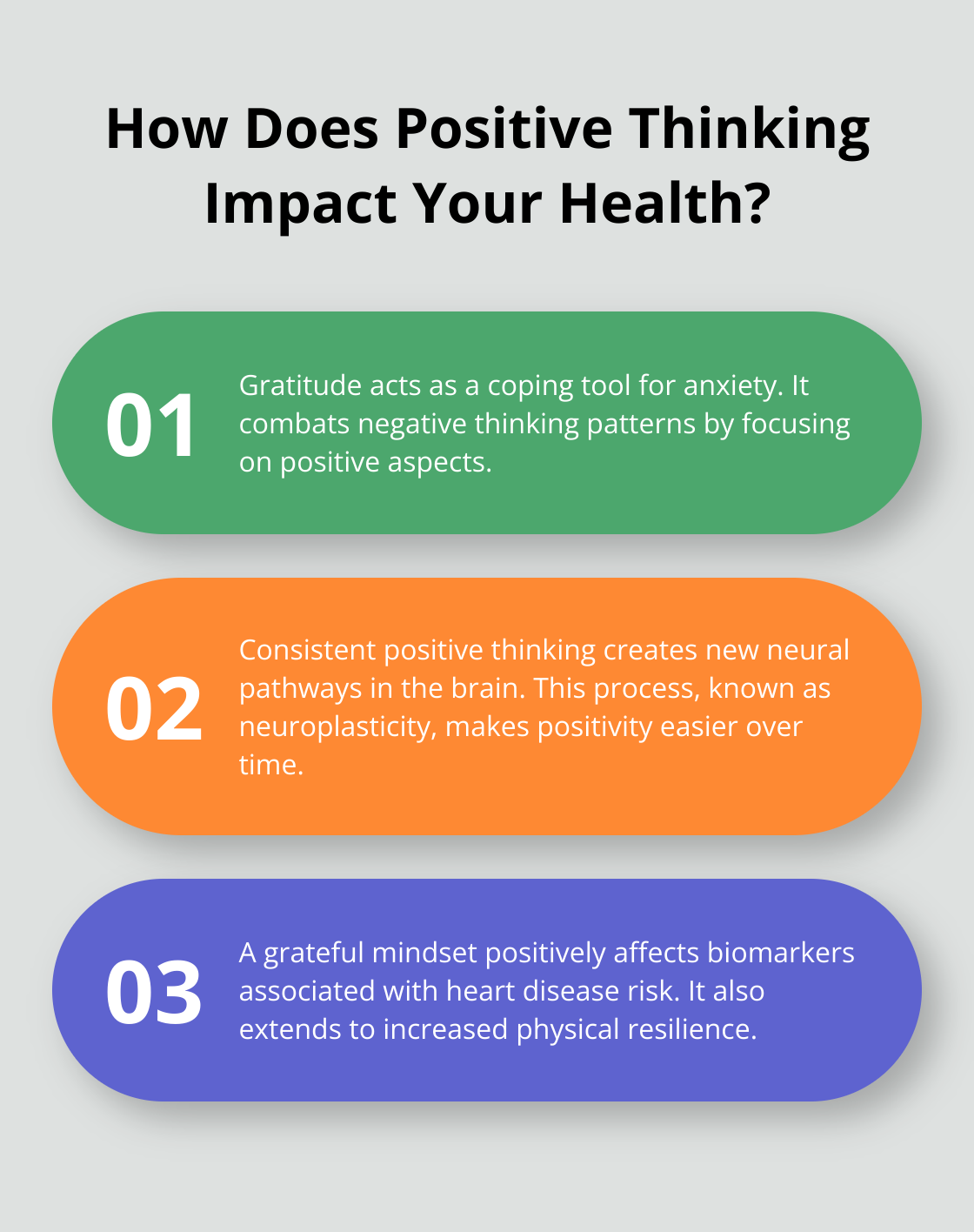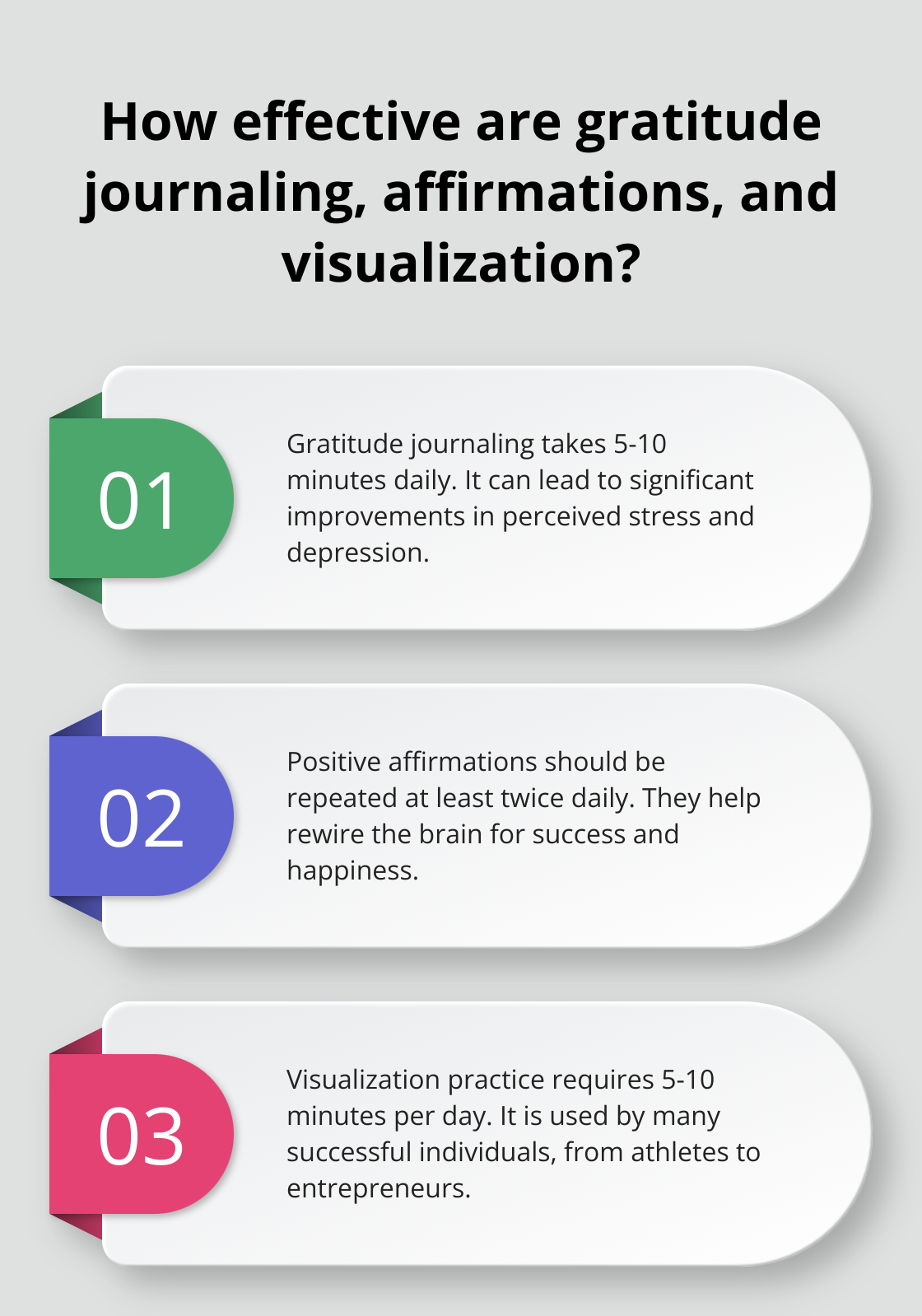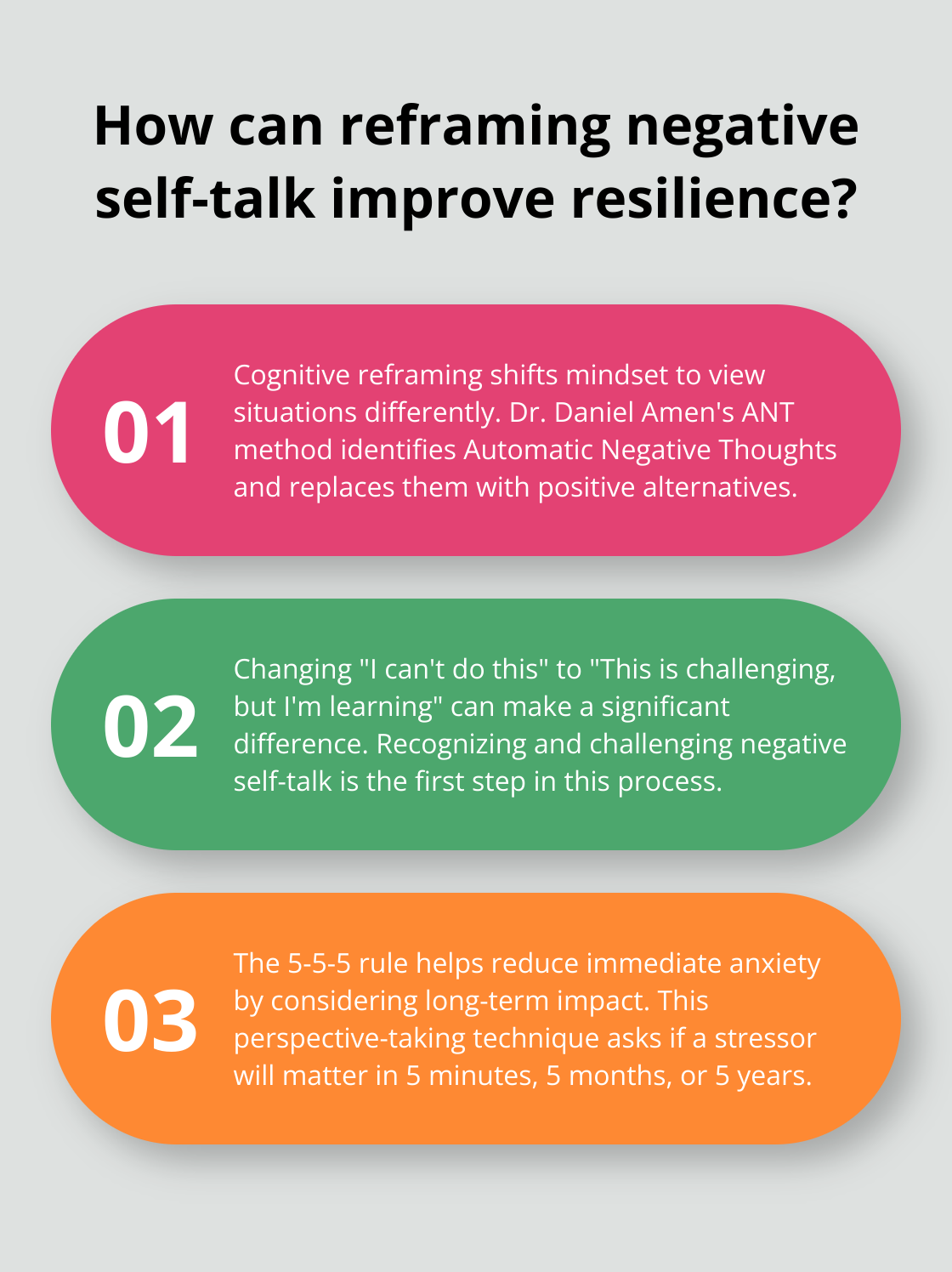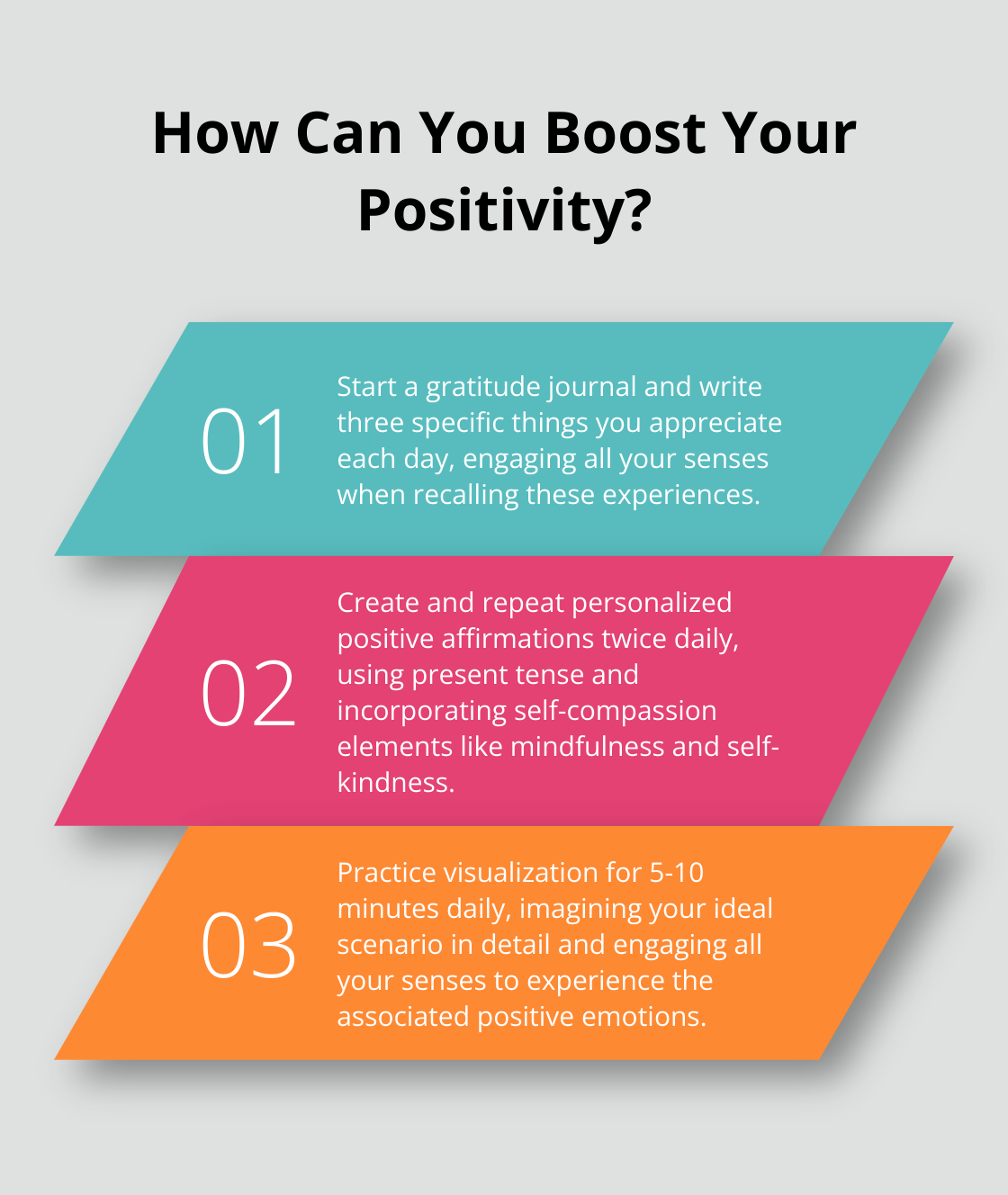At Global Positive News Network, we believe in the transformative power of daily positive reflections. These simple yet effective practices can significantly boost your mindset and overall well-being.
In this blog post, we’ll explore practical techniques for incorporating positivity into your routine and overcoming challenges that may arise along the way. Get ready to rewire your brain for happiness and success!
How Positive Thinking Transforms Your Life
The Science of Positivity
Positive thinking isn’t just a feel-good practice; it’s a powerful tool that reshapes your entire life. Research shows that gratitude can be a coping tool for anxiety and regularly practicing gratitude combats negative thinking patterns by keeping thoughts focused on positive aspects. This isn’t just about living longer; it’s about living better.
Rewiring Your Brain for Happiness
Your brain adapts to your thought patterns. When you consistently engage in positive thinking, you create new neural pathways. This process, known as neuroplasticity, means that the more you practice positivity, the easier it becomes. Dr. Rick Hanson, a neuropsychologist, explains that focusing on positive experiences for just 10-20 seconds several times a day can lead to lasting changes in brain structure.
The Ripple Effect of Positivity
Positivity in your routine doesn’t just affect your mental state; it has far-reaching benefits. Several studies show that a grateful mindset positively affects biomarkers associated with the risk for heart disease. This extends to physical resilience too.
Practical Steps to Harness Positivity
Start your day with a positive affirmation (e.g., “Today will be a good day” or “I am capable of handling whatever comes my way”). Set aside 5 minutes each evening to reflect on three positive things that happened during your day. This practice, recommended by positive psychology expert Dr. Martin Seligman, has shown to increase happiness and decrease depressive symptoms.
Positivity Amidst Challenges
Positive thinking doesn’t mean ignoring life’s difficulties. Instead, it involves approaching challenges with a growth mindset. When faced with a setback, ask yourself, “What can I learn from this?” or “How can I use this experience to grow?” This shift in perspective can turn obstacles into opportunities (and often leads to unexpected personal growth).

As we move forward, let’s explore specific techniques you can use to cultivate these positive reflections in your daily life. These practical methods will help you build a robust foundation for a more optimistic outlook.
Practical Techniques to Boost Your Daily Positivity
Gratitude Journaling: Your Daily Dose of Appreciation
Gratitude journaling shifts your focus to the positive aspects of your life. Set aside 5-10 minutes each day, preferably in the morning or before bed. Use a dedicated notebook or a digital app to record three things you appreciate. Be specific and avoid repeating entries. For example, instead of writing “I’m grateful for my family,” write “I’m grateful for the supportive phone call I had with my sister today.”

Studies have shown that gratitude list interventions can lead to significant improvements in perceived stress and depression. To maximize benefits, engage all your senses when recalling the positive experiences you write about.
Crafting Powerful Positive Affirmations
Positive affirmations are short, powerful statements that help rewire your brain for success and happiness. To create effective affirmations, follow these guidelines:
- Use present tense: “I am” instead of “I will be”
- Make them positive: “I am confident” rather than “I am not shy”
- Keep them short and specific
- Make them personal and meaningful to you
For example, “I handle challenges with grace and creativity” or “I attract positive opportunities into my life daily.”
Dr. Kristin Neff, a self-compassion researcher, suggests incorporating self-compassion into your affirmations. Self-compassion comprises three elements: mindfulness, common humanity, and self-kindness.
Repeat your chosen affirmations at least twice daily, ideally in front of a mirror. The key is consistency – even if you don’t believe them at first, regular repetition can lead to significant mindset shifts over time.
Visualization: Painting Your Ideal Future
Visualization is a technique used by many successful individuals (from athletes to entrepreneurs). It involves creating a vivid mental image of your desired outcome or state of being.
To practice visualization:
- Find a quiet space where you won’t face disturbances
- Close your eyes and take a few deep breaths to relax
- Imagine your ideal scenario in as much detail as possible
- Engage all your senses – what do you see, hear, smell, taste, and feel?
- Allow yourself to experience the positive emotions associated with this vision
Try to visualize for 5-10 minutes daily, perhaps right after waking up or before an important event. You can visualize both short-term goals (like a successful presentation) and long-term aspirations (like your ideal career or lifestyle).
These techniques prove most effective when practiced consistently. Start small, perhaps with just one technique, and gradually incorporate others as you build your positivity practice. As you master these techniques, you’ll likely encounter challenges in maintaining your positive mindset. Let’s explore strategies to overcome these obstacles and build resilience through positive reflection.
Navigating Negativity: Your Roadmap to Resilience
Reframing Negative Self-Talk
Negative self-talk can obstruct positivity. The first step is to recognize it. Pay attention to your inner dialogue. When you catch yourself thinking “I can’t do this” or “I’m not good enough,” pause. Challenge these thoughts. Ask yourself, “Is this really true? What evidence do I have to support or refute this belief?”

Next, reframe the thought. Instead of “I can’t do this,” try “This is challenging, but I’m learning and improving.” This simple shift can make a world of difference. Cognitive reframing is a technique used to shift your mindset so you’re able to look at a situation, person, or relationship from a slightly different perspective. Dr. Daniel Amen, a renowned psychiatrist, suggests using the “ANT” method – Automatic Negative Thoughts. Identify these ANTs, then squash them with evidence-based positive alternatives.
Positivity in Tough Times
When life gets difficult, maintaining a positive outlook can seem impossible. But it’s during these times that positivity is most important. Here are some strategies:
- Use the 5-5-5 rule: When stressed, ask yourself if this will matter in 5 minutes, 5 months, or 5 years. This perspective can help reduce immediate anxiety.
- Create a ‘joy jar’: Write down one positive thing each day on a slip of paper and put it in a jar. On tough days, read through these notes to remind yourself of the good in your life.
- Perform acts of kindness: Helping others can boost your own mood. A study published in the Journal of Happiness Studies found that people who performed acts of kindness for seven days saw a significant increase in happiness.
- Limit negative input: Be mindful of the media you consume. Too much negative news can impact your outlook. Balance your intake with positive sources (like Global Positive News Network).
Building Resilience Through Reflection
Resilience isn’t about avoiding difficulties; it’s about bouncing back stronger. Positive reflection is a powerful tool for building this resilience. Here’s how to incorporate it into your routine:
- Reflect at the end of the day: Before bed, ask yourself, “What went well today?” and “What did I learn?” This practice helps you focus on growth and positivity, even on challenging days.
- Celebrate small wins: Acknowledge your daily accomplishments, no matter how small. This builds confidence and motivation.
- Learn from setbacks: When facing a disappointment, ask, “What can I take from this experience?” This turns setbacks into opportunities for growth.
- Practice self-compassion: Treat yourself with the same kindness you’d offer a friend. Research by Dr. Kristin Neff shows that self-compassion is more effective than self-criticism in motivating personal growth.
Building resilience and maintaining positivity requires consistent practice and patience. As you implement these strategies, you’ll find your ability to navigate challenges and maintain a positive outlook grows stronger each day.
Final Thoughts
Daily positive reflections transform lives through simple yet powerful practices. Gratitude journaling, positive affirmations, and visualization rewire our brains for happiness and success. These techniques boost mindsets, improve well-being, and build resilience against life’s challenges.

Start your positive reflection practice with one technique that resonates with you. Dedicate a few minutes each day to this practice, and you’ll notice significant changes in your outlook and experiences. Consistency will help you develop a stronger positivity muscle over time.
We at Global Positive News Network support your journey towards positivity. Our platform offers uplifting news, inspiring stories, and practical tips to maintain an optimistic perspective. Take the first step today and join millions worldwide in creating a brighter, more positive future for yourself and others.




